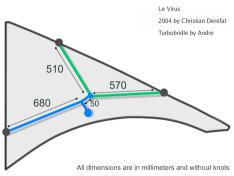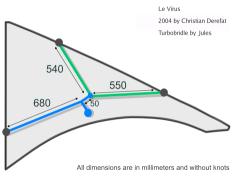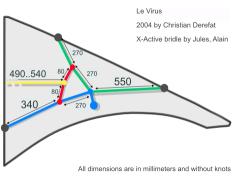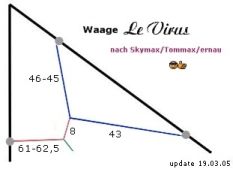
Under Construction - Construction of "Le Virus"
On this page you'll find a description on how to make the various parts of Le Virus.
Basic construction of a kite
A
lot could be said on how to construct a kite in general. Luckily there
are already a number of places where you can look for information
and find some nice detailled pictures. Simo Sivonen, a very nice Finnish guy who
designs his own kites, described the building of his kite, the Orange.
His page is filled with detailled pictures on how to construct
different parts of a kite. Although these pages focusses on the Virus I
should mention the Orange is also a nice kite to make and have in your
collection. Highly recommended, both the description of making the
Orange as well as the Orange itself.
Another nice fellow, Stan Kellar, offers some more advice on his pages of building kites in general and making dualline stuntkites.
A third possibility is an article with nice detailled pictures at a German site called Drachenforum.net.
The Virus seams are normally
sown using a sailmaker or three-step zig-zag stitch. If however you
would want to equip your Virus with a flat fell seam here is a detailled article. It's one article in a series on how to make the Pizazz kite.
This page will focus on the special parts that make up for the Virus, such as the winglets, yoyo-stoppers and other parts.
Quick description
Here's a very quick description from Christian (translated by Toni) on how to build Le Virus:
- Cut the different pieces of sail, assemble on the plan, sew
- glue the addit. part on the spine, the top cross (contact with the spine), the wing tips, and sew them
- Put
the addit. part (where the leech line will be placed) on the leech edge
until the wing tips but not the last part (the one between the winglet
and the tip), sew.
- Put
the leech line, with a bold needle, sew it near the winglet. Sew the
last part, without the leech line inside it, on the leech edge (between
the winglet and the tip).
- Glue
the dacron (25mm) for the winglet, except a little hole to insert them
later. Put mylar inside and on the other part of the sail (stronger).
Put the winglet spar (7 cm long) sew. Glue the leading edge, sew it.
- Glue and sew the scratch on the spine, the different strengthen pieces (standoffs insertion, nose)…
@brinm00: need to clean up a bit..
Winglets
The winglet is made of a small (7cm) 2mm CFK spar sewed inside a Dacron pocket with 15 mm less on the leading edge.
Sew the 'pocket', put the 2mm CFK spar inside and close, and then sew on the dacron.
You can look at a picture and another of the winglet on how this works out on the Virus.
Whiskers
In this case a picture will say more than thousand words....
Leechline
One
of the most asked questions about Le Virus so far is how to construct
the leechline. It turns out the leechline runs from winglet to winglet
and is sewed there in place. Like with the whiskers a picture explains this more clearly.
The leechline is there to add
some some strength to the trailing edge during roll-up moves, not to to
make the kite silent. Also you will loose speed control when using a
tight leechline.
Another aspect is that a too tight leechline will pull the winglets
together and thus hinders their free movement. So the consensus seems
to be on a not too tight leechline made out of one piece.
If however you would want to experiment with the tension of the leechline here is a picture showing how to do it (@brinm00: translation needed):
Die Enden der Saumschnur
werden vom Saumende über den Schlauch am Kielstabende
geführt und sind zu langen Schlaufen verknotet.
Eine Gummischnur liegt hinter dem Center-T-Verbinder und hat auf der
einen Seite nur einen Knoten und auf der anderen mehrere, so
daß man die Saumschnur mit der Gummischnur verbinden und wie
bei einer Knotenleiter an einer Waage in der Spannung verstellen kann.
Das Klettband für die Kielstababspannung hält
über der Saumschnur genauso gut wie ohne. Man kann die Enden
aber auch durch den Tunnel ziehen. Eine wunderbar "technische"
Lösung, wie ich finde.
Avoiding ugly folds
To
avoid some ugly folds after assembling the kite, you have to cut the
sail a little.
On both halves of the sail cut a little curve starting from the center
T to the end of the spine. You start at the center T at 0mm and at the
end of the spine you will have 6mm. A picture shows the template Christian is using on his Virusses.
Yo-Yo stoppers
The Yo-Yo stoppers should be at 56cm from the nose-tip.
Weight
Le Virus performs at its best with some 15gr of weight on its tail.
Bridles
There's a lot that can be said about bridles. Luckily there's already a lot of information on bridles out there. The best
place to start out if you want to know how to tie your own bridles, which knot to use and what bridle variants there are, is at Andy Wardley's bridle pages.
That said, there already a number of bridles available for Le Virus (@brinm00: add characteristics of each bridle):
 Christian's original 3-point bridle.
Christian's original 3-point bridle.  Turbo bridle by Andre.
Turbo bridle by Andre.  Jules' combination of the 3-point and the turbo bridle.
Jules' combination of the 3-point and the turbo bridle.  Cross active bridle based on the original 3-point bridle. Warning: this bridle is still beeing tested so dimensions may change in the future.
Cross active bridle based on the original 3-point bridle. Warning: this bridle is still beeing tested so dimensions may change in the future.  Reverse turbo bridle by Christian himself.
Reverse turbo bridle by Christian himself.  Turbo bridle by Tommax.
Turbo bridle by Tommax. 